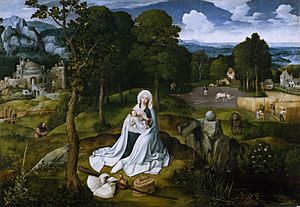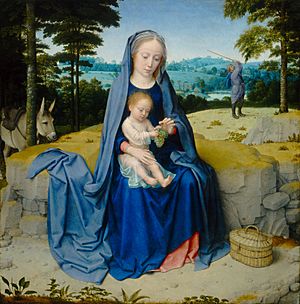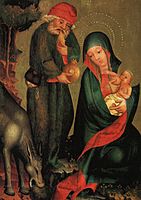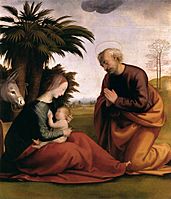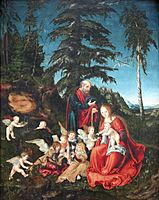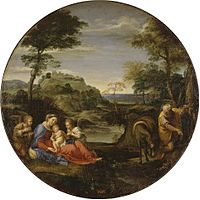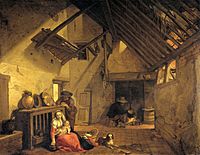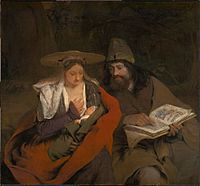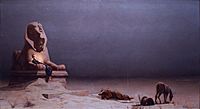Rest on the Flight into Egypt facts for kids
The Rest on the Flight into Egypt is a popular topic in Christian art. It shows Mary, Joseph, and baby Jesus taking a break during their journey to Egypt. This journey is known as the Flight into Egypt. Artists usually show this holy family resting in a beautiful outdoor scene.
This art topic became popular in the late 1300s. It grew from older stories about their journey, like when they stopped to eat dates from a palm tree. The New Testament (part of the Bible) only says they went to Egypt. It does not give many details about their trip. Artists and writers later added more moments to this story.
The first known painting of the Rest is from about 1379. It is a panel in the large Grabow Altarpiece by Meister Bertram. For a long time, this subject was mostly seen in northern Europe. Many of these paintings were made for wealthy homes, not churches. As landscape painting became more popular, the "Rest" scene became very common. By the late 1500s, it might have been even more popular than showing the family actually traveling.
In these artworks, the figures are often just resting. Sometimes, they are shown camping or having a picnic. Angels might even be helping them. In older paintings, Mary is sometimes shown breastfeeding baby Jesus. Joseph might be busy gathering firewood or getting water. But in later artworks, he is often shown fast asleep. Mary rarely sleeps in these scenes. In larger landscapes, artists sometimes show other legendary events from the Flight into Egypt happening far away.
Why Artists Painted This Scene
The Bible's book of Matthew 2:14 simply says Joseph "took the young child and his mother by night, and departed into Egypt." This short sentence led to many other stories. These extra stories were written in early books not included in the main Bible. Later medieval stories added even more details. For example, a book from 1374 described Mary breastfeeding. This detail appears in the first known painting of the Rest. The book also talked about the journey through "dark and uninhabited forests." This helped artists create the many landscape settings we see.
Some miracle stories, like the palm tree giving dates or pagan statues falling, were later not approved by the Church. So, these specific miracles stopped appearing in art. However, it was clear that the Holy Family would need to rest during such a long journey. So, the "Rest" scene was seen as a real and acceptable topic for art. This subject also fit with new ideas from the Counter-Reformation. This movement wanted to show New Testament stories in a more realistic way. It also wanted to give Saint Joseph a bigger role. Because of this, the "Rest" scene grew even more popular. One old story said a spring appeared when they needed water. So, many "Rest" paintings show the family by a spring or stream.
How the Paintings Changed
The painting in the Grabow Altarpiece shows the family eating and drinking. Baby Jesus is breastfeeding, the donkey drinks from a stream, and Joseph eats bread. He offers Mary a bottle. This painting has a gold background, but it also shows landscapes around the edges. For about 100 years after this, there were not many paintings of the Rest. A painting by Hans Memling (at the Louvre) then led to a big increase in these scenes. His work also started including miracles in the background.
Around the year 1500, in paintings from the Netherlands, Mary and Jesus often took up most of the picture. Joseph and the donkey might be smaller and further away. In a painting by Gerard David in Washington, DC, Joseph is in the background. He is getting food by hitting a chestnut tree with a stick. This detail might have come from pictures in old prayer books. These books often showed people working during different months of the year.
Usually, in paintings of the Flight itself, Joseph walks while Mary and Jesus ride the donkey. But in Rest scenes, Joseph is often standing. He might be doing something active. After the High Renaissance period, he often stands behind Mary. This creates a triangle shape with Mary and angels around her. Few paintings show Joseph sitting and resting his feet next to Mary or eating.
Larger landscapes, like the one by Joachim Patinir in the Prado, show more details. In the distance, you can see the Massacre of the Innocents (which caused the flight) and the "miracle of the corn." The donkey is eating grass nearby. Joseph seems to have gotten a pot of milk. Many artists, like Jan Brueghel the Elder and Jan Brueghel the Younger, made many versions of the Rest.
Some paintings show special activities. For example, in a famous painting by Caravaggio, Joseph holds sheet music for an angel playing a musical instrument. In this painting, both Mary and Jesus are asleep. The Bible says the flight began "at night." But night scenes were rare in art for a long time. In a night scene by Rembrandt (1647, Dublin), the family seems to have joined some shepherds by a big fire. This is Rembrandt's only night landscape.
Sometimes, it's hard to tell the difference between a "Rest on the Flight" and a "Holy Family in Egypt" painting. If John the Baptist is present or there's a house nearby, it might be the "Holy Family in Egypt." If the traditional donkey is there, it usually means it's a "Rest" scene. The "rest" was sometimes thought to include their whole stay in Egypt, which some stories said lasted seven years. A woodcut by Albrecht Dürer is called a Rest on the Flight. But it shows Joseph settled in Egypt, working on carpentry with angels helping him.
Paintings of the Flight that include the miracle of the date palm can also look like a Rest. For example, in an old print by Martin Schongauer, Mary stays on the donkey while Joseph gathers dates. From about 1550, Italian paintings often showed many small, chubby angels called putti. This idea came from German prints and paintings.
General trends in landscape painting also affected these scenes. Artists like Joachim Patinir loved to place the family in huge, wide landscapes. Other artists focused on larger figures of Mary and Jesus.
In the 1700s, paintings often showed the scene next to old Roman ruins. Some 1800s paintings even featured Ancient Egyptian architecture. Some Romantic paintings showed the scene in beautiful, paradise-like settings.
Examples
- Rest on the Flight into Egypt, by Titian, around 1512, Longleat House, Wiltshire
- Rest on the Flight to Egypt with Saint Francis, by Correggio, around 1520, Uffizi, Florence.
- The Rest on the Flight into Egypt, by Paris Bordone, around 1530, Musée des Beaux-Arts, Strasbourg
- Rest on the Flight into Egypt, around 1597, by Caravaggio, Doria Pamphilj Gallery, Rome
- Rest on the Flight into Egypt, 1630, by Anthony van Dyck, Alte Pinakothek, Munich.
- The Rest on the Flight into Egypt, 1640s (?), oil on copper, by Pier Francesco Mola, Metropolitan Museum of Art, New York
- Rest on the Flight into Egypt, around 1665, by Bartolomé Esteban Murillo, Hermitage Museum, St Petersburg.
Gallery
-
Fra Bartolomeo, 1500. An early Italian example, showing the start of the subject's popularity.
-
Lucas Cranach the Elder, 1504, Gemäldegalerie, Berlin
-
Follower of Joachim Patinir, around 1515. The main panel is surrounded by smaller scenes from the life of Christ, National Museum of Western Art.
-
Annibale Carracci, around 1604, Hermitage Museum
-
Abraham Bloemaert, 1632, Rijksmuseum
-
Aert de Gelder, around 1690, Museum of Fine Arts, Boston
See also
 In Spanish: Descanso en la huida a Egipto para niños
In Spanish: Descanso en la huida a Egipto para niños


